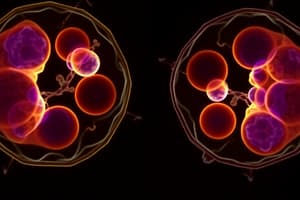Podcast
Questions and Answers
What is the primary function of cells in living organisms?
What is the primary function of cells in living organisms?
- To consume energy from the environment
- To facilitate communication between organisms
- To perform specific functions through organelles (correct)
- To store genetic information
Which of the following is NOT a reason for cell division?
Which of the following is NOT a reason for cell division?
- To replace worn out or dead cells
- To increase energy production (correct)
- To allow organisms to grow
- To reproduce themselves
How does the cell cycle differ among various types of cells?
How does the cell cycle differ among various types of cells?
- Cycle length varies with the organism type only
- Cell cycle length differs between individual cells (correct)
- All cells have the same cycle length
- Cell cycle depends solely on external environmental conditions
What does the life cycle of a living organism generally begin with?
What does the life cycle of a living organism generally begin with?
Which example demonstrates a significantly shorter cell cycle?
Which example demonstrates a significantly shorter cell cycle?
What is the main purpose of the G1 phase in the cell cycle?
What is the main purpose of the G1 phase in the cell cycle?
What occurs during the S phase of interphase?
What occurs during the S phase of interphase?
Which structure is responsible for separating chromatids during anaphase?
Which structure is responsible for separating chromatids during anaphase?
What is the first stage of mitosis?
What is the first stage of mitosis?
What is the significance of chromatids during cell division?
What is the significance of chromatids during cell division?
During which phase do chromosomes line up at the center of the cell?
During which phase do chromosomes line up at the center of the cell?
Which phase of the cell cycle is characterized by extensive cellular activity, but not division?
Which phase of the cell cycle is characterized by extensive cellular activity, but not division?
What is the term for identical cells produced after mitosis?
What is the term for identical cells produced after mitosis?
Flashcards
Cell
Cell
The basic building blocks of life, made of organelles.
Cell Division
Cell Division
The process important for growth, repair, and reproduction.
Cell Cycle
Cell Cycle
The life cycle of a living organism including formation, growth, and death.
Length of Cycle
Length of Cycle
Signup and view all the flashcards
Organelles
Organelles
Signup and view all the flashcards
Interphase
Interphase
Signup and view all the flashcards
G1 Phase
G1 Phase
Signup and view all the flashcards
S Phase
S Phase
Signup and view all the flashcards
G2 Phase
G2 Phase
Signup and view all the flashcards
Mitosis
Mitosis
Signup and view all the flashcards
Chromatid
Chromatid
Signup and view all the flashcards
Stages of Mitosis
Stages of Mitosis
Signup and view all the flashcards
Study Notes
The Cell Cycle & Mitosis
- Cells are the fundamental building blocks of all living organisms
- Every living organism is composed of one or more cells
- Cells are made of organelles, which work together to perform specific functions
- Cells are present in every part of an organism
The Cell - Basic Unit of Life
- Cells contain various organelles, including Golgi complex, nucleus, mitochondria, nuclear envelope, and plasma membrane
- Cells have different sizes and structures depending on their function and location
Cell Division
- Cell division is critical for growth, replacing worn-out or dead cells, and reproduction
- The cell life cycle begins with the organism's formation, growth and development and ends with death
Length of Cell Cycle
-
Cell cycle length varies among different organisms and cell types.
-
Bean plants take 19 hours to complete a cycle
-
Embryos complete the cycle in under 20 minutes
-
Some human cells cycle in 16 hours
-
Skin and bone cells regularly repeat the cycle for repair, growth, or replacement
Stages of Cell Cycle
- The cell cycle has two primary stages: Interphase and Mitosis
Interphase
- Most of a cell's life is spent in interphase
- It's a period for growth and development
- Interphase is divided into three phases: G1, S, and G2
Interphase - G1 Phase
- The cell grows larger (doubles in size).
- Cellular functions occur.
- Organelles replicate
Interphase - S Phase
- DNA in the nucleus is copied (chromosomes duplicate)
- Chromosomes contain hereditary information for the cell.
Interphase - G2 Phase
- The cell continues to grow.
- It prepares for cell division (mitosis)
Mitosis
- Mitosis is the process where a cell divides to produce two identical cells (daughter cells)
Chromosomes
- Chromosomes carry genetic material passed to daughter cells
- Chromosomes are found in the nucleus
- During interphase, chromosomes duplicate
Chromosome --> Chromatid
- A duplicated chromosome consists of two identical strands called chromatids
- The chromatids are held together by a centromere
Steps of Mitosis
- Mitosis has four main stages: Prophase, Metaphase, Anaphase, and Telophase
Prophase
- Chromosome pairs become visible
- Two small structures called centrioles move to opposite ends of the cell
- A spindle fiber forms between the centrioles, extending across the cell
Metaphase
- Pairs of chromatids line up at the cell's center (middle)
- Each pair of chromatids is attached to two spindle fibers (one for each side of the cell)
Anaphase
- The centromere divides
- Spindle fibers shorten
- Chromatids separate and move to opposite ends of the cell
Telophase
- Spindle fibers disappear
- Chromosomes uncoil
- New nuclei form
Cytokinesis
- Cytoplasm separates
- Two daughter cells are formed
Studying That Suits You
Use AI to generate personalized quizzes and flashcards to suit your learning preferences.




